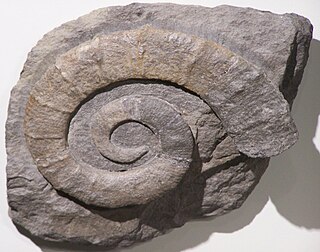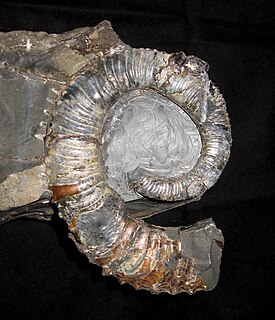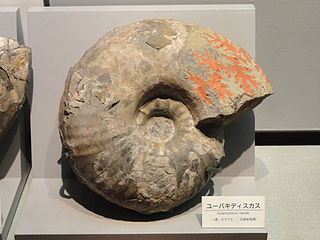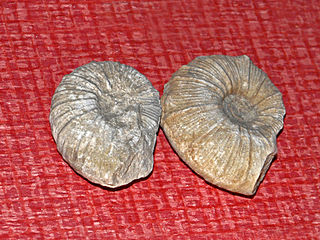
Abrytasites (Abrytusites) is an extinct genus of cephalopods belonging to the Ammonoidea subclass. The genus was named after the ancient Roman town of Abrittus, located near the present Bulgarian city of Razgrad. There are several described species of Abrytasites, including A. thieuloyi, A. julianyi, and A. neumayri. They are inflated, with constrictions, have rather thick ribs springing irregularly, singly or in pairs, from umbilical bullae. Their inner whorls closely resemble types species of Valdedorsella. This animal lived 125-136.4 million years ago during the Hauterivian and the Barremian in Europe and western Africa.
Kamerunoceras is an extinct cephalopod genus belonging to the ammonite family Acanthoceratidae, found in Upper Cretaceous formations of Africa, Europe and North and South America.
Anagaudryceras is an extinct genus of ammonite from the later Cretaceous belonging to the Ammonoidea family Gaudryceratidae. Anagaudryceras has a moderately involute shell with a deep umbilicus and strongly ribbed outer whorl. Ribs are thick and rounded and cross over the venter uninterrupted.
Baculina is an extinct ammonoid cephalopod genus belonging to the ancylocerid family Bochianitidae. Baculina is known from the Valanginian of the Lower Cretaceous.
Anisoceratidae is an extinct family of heteromorph ammonites which belong to the Ancyloceratina superfamily Turrilitoidea. Members of the family range is from the lower Albian to the upper Turonian. The family is possibly derived from a member of the Hamitidae.

Desmoceratidae is a family belonging to the ammonite superfamily Desmoceratoidea. They are an extinct group of ammonoids, shelled cephalopods related to squid, belemnites, octopuses, and cuttlefish, and more distantly to the nautiloids, that lived between the Lower Cretaceous and Upper Cretaceous.

Crioceratites is an ammonite genus from the Early Cretaceous belonging to the Ancyloceratoidea.

Exiteloceras is an ammonite genus from the Late Cretaceous.
Ancyloceratoidea, formerly Ancylocerataceae, is a superfamily of typically uncoiled and loosely coiled heteromorph ammonoids established by Alpheus Hyatt in 1900, that may contain as many as 11 families, depending on the classification accepted.

Eupachydisus is a large, coarse-ribbed Pachydiscid ammonite genus from the Upper Cretaceous, found in Coniacian to Campanian age strata in Europe, Madagascar, Japan, and British Columbia.

Collignoniceratidae is a family of Upper Cretaceous ammonites characterized by typically more or less evolute shells with compressed, oval, or square whorl sections; serrate or entire keels; and dense ribs with one to 5 tubercles.
Bochianites is a straight shelled ammonite which lived from the Upper Jurassic, Tithonian, to the Lower Cretaceous, Hauterivian in what is now Europe, Greenland, Africa, North America and Asia. The shell is long, narrow, moderately expanding; smooth or with weak to strong oblique annular ribs. Sutural elements are short and boxy. The umbilical lobe, which lies between the lateral lobe and dorsal lobe, on either side, is about the same size as the lobule dividing the first lateral saddle.

Stoycho Vassilev Breskovski was a Bulgarian paleontologist.

Ancyloceratidae is a family of heteromorphic ammonites that lived during the Early Cretaceous. Their shells begin as a loose spiral with whorls not touching which then turns into a straight shaft that ends in a J-shape hook or bend at end. Coarse ribbing and spines are common.
Hypophylloceras is a Cretaceous ammonite with a finely ribbed, compressed, involute shell; some having periodic stronger ribs or folds. The suture is complex, with large, asymmetric and finely divided lobes; the 1st lateral being much larger than the external (=ventral) and 2nd lateral lobes. Saddle endings commonly not phylloid.

Calliphylloceras is an ammonite belonging to the Phylloceratidae.

Neocomitidae is a family of Lower Cretaceous ammonitids comprising genera with strongly ribbed evolute to smooth, fairly involute shells.

Holcodiscus is an ammonite genus placed in the family Holcodiscidae. Species in this genus were fast-moving nektonic carnivores. The type species of the genus is Ammonites caillaudianus.

The Acanthoceratinae comprise a subfamily of ammonoid cephalopods that lived during the Late Cretaceous from the latter early Cenomanian to the late Turonian
Cunningtoniceras is a stocky acanthoceratid ammonite from the upper Cenomanian stage of the late Cretaceous of the western U.S., found e.g. in Arizona and New Mexico.











